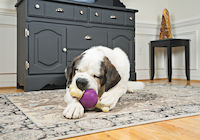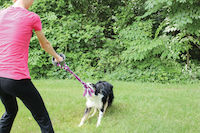Wolf cubs hone their hunting skills through play with their siblings and pack members and by toying with small prey or morsels brought to them by their parents. The wolf is the ancestor of modern dogs, but modern dogs remain like immature wolf cubs and generally do not develop the habits of an adult wolf.
Our pet dogs have a natural instinct to practice hunting skills, like wolf cubs, but in a diluted form. Pet dogs do not generally go on to engage in predatory hunting like a mature wolf would.
Kittens of the African Wildcat practice their hunting skills in the same way as a wolf cub. The African Wildcat is the ancestor of modern cats but the difference between pet cats and dogs is that the cat’s instinct to hunt is less diluted. Kittens practice hunting through play and often put it into practice as adults.
Toys allow pets to engage in hunting behaviour such as stalking, pouncing, chasing and catching. Toys can be chewed or pulled apart to reveal potential treats. They provide hours of occupation and help prevent boredom and the development of behavioural issues.
Pet toys need to appeal to pets, not to their human owners. It should not matter if the owner finds a toy appealing, it matters what the pet thinks. Toys that have been developed in conjunction with animal behavourists and vets will fulfil a pet’s requirements to express natural behaviour, as they understand how animals think and function.
We like to think that owners will find our toys attractive but our primary aim is to ensure your pet’s quality of life is improved as a result of playing with them.
“Toys provide hours of occupation and help prevent boredom”
 As explained, our pet’s play is likely to mimic hunting or foraging skills.
As explained, our pet’s play is likely to mimic hunting or foraging skills.
Play is important because:
There are many types of toy, which allow pets to express their natural instinct and provide them with stimulating challenges.
Our range of dog toys fall into three different categories and each category allows the pet to practice different play activities. The range includes treat dispensing and treat holding toys, puzzle toys and challenging enrichment toys. Enrichment toys promote activity and create a longer lasting playtime.
The dog toys are available for adult dogs and puppies with various sizes within each group. Some toys, which dispense treats through an opening during play, have a Treat Meter™ - soft and adjustable rubber prongs that move aside to allow for easy stuffing of treats and food into the toy. As the dog plays, treats will randomly fall through the opening, rewarding the dog and encouraging further play for hours of fun. The Treat Meter prongs can be cut to make an easier flow of food and treats.
Our cat toys are designed to keep cats of all ages engaged, active and stimulated by randomly dispensing treats and dry food. They are adjustable and adaptable to individual cats enabling you to increase the challenge over time.
“Pet toys need to appeal to pets, not to their human owners”
 Our toys have been manufactured to be as safe as possible for pets. Dogs in particular, explore objects with their mouths, much like young children. If indigestible objects of a certain size are swallowed they can cause bowel blockages, which may require surgical intervention.
Our toys have been manufactured to be as safe as possible for pets. Dogs in particular, explore objects with their mouths, much like young children. If indigestible objects of a certain size are swallowed they can cause bowel blockages, which may require surgical intervention.
Each toy comes in a variety of sizes and each is appropriate for a size range of dog. Owners must choose the correct size toy to reduce the risks of them being swallowed whole or quickly broken up into large pieces which may cause a blockage if swallowed. Many pet toys are designed to be chewed and destroyed slowly and only small pieces break off which if swallowed will pass through the bowel. Eventually the bulk of the toy may be reduced to a size that could be swallowed and at this point
owners have a responsibility to throw it away and buy a new one!
“To maintain interest new toys need to be introduced and old toys rotated”
PetSafe® is committed to improving your pet’s quality of life through continued innovation in collaboration with animal professionals.

Written and developed in conjunction with
David Chamberlain BVetMed. MRCVS
Veterinary Consultant to PetSafe
![]() 0800 0221 804
0800 0221 804
Monday to Friday
09:30 - 18:00
Need help with a product?
Customer service is at the heart of everything we do. We're committed to giving you expert advice to ensure you always receive the very best.
To get the most protection out of your warranty, please register your product within 30 days here.
By registering and keeping your receipt, you will enjoy the product's full warranty and should you ever need to call our Customer Care Centre, we will be able to help you faster.
© 2025 Radio Systems Corporation All Rights Reserved. Privacy Statement Cookies Policy